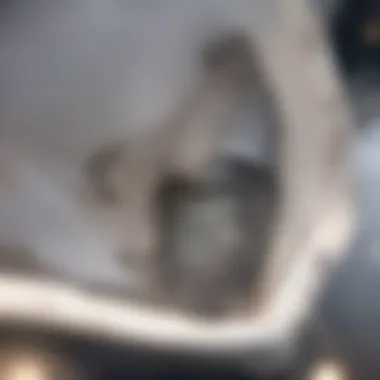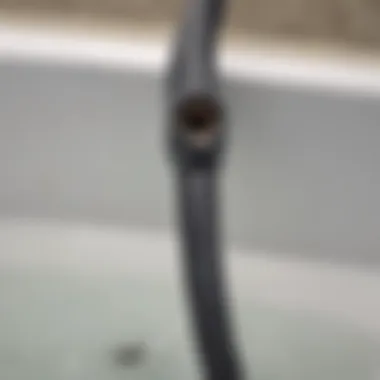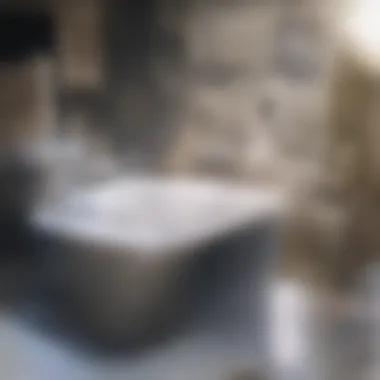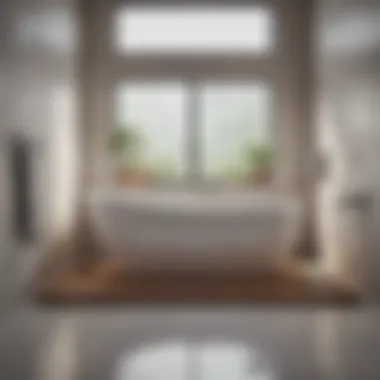Resolving Bathtub Drain Issues: A Comprehensive Guide


Intro
The issue of water not draining in a bathtub presents a frustrating scenario for many homeowners. This complication is often linked to a variety of causes, ranging from simple clogs to more complex plumbing faults. Addressing these problems is essential to maintain a clean, hygienic environment.
Understanding the dynamics of bathtub drainage can help homeowners take proactive measures. By identifying specific culprits such as hair, soap residue, or foreign objects, one can begin to formulate an effective response to restore proper functionality.
This article explores the reasons behind stagnant water in bathtubs and offers diagnostic strategies. After identifying the issue, the focus will shift to implementing solutions that can aid in efficient drainage, allowing users to enjoy their bathtubs without concern.
Understanding these aspects not only enhances home maintenance skills but also promotes a healthier lifestyle. Taking the time to address drainage issues promptly can prevent further complications, ensuring a more enjoyable bathing experience.
Understanding the Basics of Bathtub Drainage
Bathtub drainage might appear like a simple task, but it involves intricate principles that function together. Understanding the core concepts of how water drains from your bathtub is crucial for diagnosing issues later on. Having this knowledge allows homeowners to identify problems quickly, saving them time and potentially costly repairs.
The Role of Gravity in Drainage
Gravity is the fundamental force that drives water drainage in a bathtub. The design of the drain system relies on gravity to guide water away from the tub and into the plumbing system. When the bathtub is not level, or the drainage is obstructed, water can fail to drain efficiently. This can lead to stagnant water accumulating, creating unsightly and unhygienic conditions that may require immediate attention.
In typical drain systems, the drain pipe is sloped downward toward the sewer line. This slope helps gravity pull the water downwards, assisting in maintaining a proper flow. When homeowners experience slow drainage, it is essential to evaluate the angle of the drain pipe as a potential contributor to the problem.
How Bathtub Drains Are Designed
Bathtub drains are designed to manage water effectively, preventing clogs and ensuring smooth outflow. Generally, they consist of several key components: the drain body, the stopper, and the trap. Each part plays a pivotal role in functionality.
- Drain Body: This is the section embedded in the bathtub, and its design affects how water collects and empties.
- Stopper: This controls the flow of water into the drain. Homeowners must ensure it works effectively to avoid overflow.
- Trap: The drain trap is crucial in preventing sewer gases from entering the home and maintains a small amount of water to seal the system, which is essential in maintaining hygiene.
Overall, understanding these elements and their interactions helps in recognizing how minor defects can lead to significant drainage problems. An educated homeowner can act promptly to mitigate issues before they become severe.
Identifying Common Causes of Drainage Issues
Understanding the causes behind drainage problems is fundamental for effective solutions. Homeowners often face frustration when water does not drain as expected. Identifying the specific reasons can save time and potentially costly repairs. By pinpointing the source of the issue, homeowners can take appropriate action more swiftly. This section addresses the most common causes of drainage issues and the considerations for each.
Clogs Caused by Hair and Soap Residue
One of the primary contributors to bathtub drainage issues is the accumulation of hair and soap residue. As individuals use the bathtub, hair naturally sheds, and soap particles mix with water, leading to build-up in the plumbing system. Over time, this accumulative effect can create a substantial blockage.
To mitigate this problem, regular cleaning is essential. Homeowners should consider using drain screens or stoppers to catch hair before it reaches the drain. Cleaning the drain frequently can prevent further buildup by removing residues. Timely intervention can ensure the smooth flow of water and reduce potential plumbing headaches.
Foreign Objects Trapped in the Drain
Sometimes the blockage can be due to foreign objects finding their way into the drain. Items like toys, jewelry, or even toiletries can inadvertently slip into the drainage system. These objects can lead to serious clogs, requiring immediate attention.
To reduce the chance of this happening, homeowners should be conscious of what they bring into the bathtub area. Conducting a periodic check of the drain area can identify any visible obstructions. If a homeowner suspects that a foreign object is stuck in the drain, it is advisable to act swiftly to prevent further complications.
"Addressing a blockage caused by a foreign object often requires professional assistance. It is crucial to approach this issue carefully to avoid damaging the plumbing."


Issues with the Drain Trap
The drain trap plays a critical role in managing water flow and preventing sewer gases from entering the home. If the trap is malfunctioning or blocked, it can hinder the overall drainage process. Problems with the drain trap can manifest from a buildup of debris or structural issues that prevent proper flow.
Regular inspection and maintenance of the drain trap can help identify problems early on. Homeowners should know how to access and clean the trap if necessary. Failure to address drain trap issues in a timely manner can lead to more severe drainage problems, necessitating professional plumbing services to resolve.
In summary, understanding these common causes is beneficial. It allows homeowners to take proactive steps in maintaining their bathtubs and addressing issues before they escalate.
Assessing the Drainage Problem
Assessing the drainage problem is an essential step in resolving the issue of water not draining in the bathtub. Understanding the factors contributing to the stagnation of water will enable homeowners to take effective measures. The process of assessment helps identify whether the problem stems from minor clogs or more complex plumbing issues. By taking this important step, homeowners save time and potential costs associated with unnecessary repairs. A thorough assessment also lays the groundwork for targeted solutions that can restore proper drainage functionality.
Visual Inspection Techniques
Visual inspection can reveal a lot about the state of your bathtub's drainage system. Start with a look around the drain cover. Often, hair, soap residue, or other debris can collect there, causing blockages. Remove the drain cover, if possible, to have a clearer view. Pay attention to the condition of any visible pipes or connections. Look for signs of rust or corrosion around these areas. If water is still present in the tub despite a visual check, there may be hidden obstructions deeper in the system. Ensure to check the overflow drain as well, which can also trap debris.
Testing Drain Flow
Testing the flow of water is another key diagnostic measure. Fill the bathtub with a few inches of water and watch how quickly it drains away. If water drains slowly or not at all, you likely have an issue that demands attention. Take note of the rate at which water flows. If there is a sudden drop in flow after a consistent period of normal function, this may indicate a recent clog. Documenting these observations can aid in discussions with professionals if needed.
Utilizing Professional Equipment for Diagnosis
In some cases, it may be beneficial to utilize professional equipment to better diagnose the problem. Plumbing professionals often use tools like drain cameras, which allow for a visual inspection of the inside of pipes. These cameras can identify blockages, cracks, or breaks in the plumbing that may not be visible through standard inspection techniques. Additionally, pressure tests may be used to assess the integrity of the drain systems further. Utilizing these advanced diagnostic methods will lead to a more informed and targeted approach to fixing any drainage problems.
Solutions to Fix Bathtub Drainage Problems
When a bathtub fails to drain properly, it can lead to many inconveniences and health concerns. Understanding how to effectively rectify drainage problems is essential for maintaining hygiene and the overall functionality of the bathroom. Solutions can vary based on the causes of the issue, making it crucial to explore various approaches.
Manual Clearing of Clogs
Manual clearing is often the first step in addressing drainage problems. Homeowners should be aware that many clogs can be resolved without professional help. This approach saves time and money.
When using manual methods, methods like removing visible debris from the drain should be attempted first. This is effective for simple blockages caused by hair or soap. It requires minimal tools, making it accessible for most homeowners.
Plumbing Tools for Removal
Different plumbing tools can assist in removing stubborn clogs. Each tool ofers unique benefits that cater to specific situations. Here are some common tools:
Plunger
The plunger is one of the most essential tools for tackling drain blockages. It works by creating suction that can dislodge objects blocking the drain. The key characteristic of a plunger is its ability to generate pressure through a simple pushing and pulling action.
This tool is popular due to its ease of use and low cost. The unique feature of a plunger lies in its effective suction, enabling it to clear many common blockages quickly. However, over-reliance can potentially lead to damage if misused.
Drain Snake
The drain snake is a flexible tool made to reach deep into the plumbing system. It is effective for removing clogs formed far from the drain opening. The key characteristic of the drain snake is that it can navigate through bends in pipes to reach stuck debris.


This tool provides a significant advantage when dealing with hair or larger obstructions. On the downside, a drain snake requires some skill to operate effectively, which can be a drawback for a novice user.
Wet/Dry Vacuum
A wet/dry vacuum serves as a powerful option for tackling drainage issues. This device can quickly suck out both liquid and solid blockages from the drain. The key characteristic of a wet/dry vacuum is its versatility and suction power, making it beneficial in cleanup efforts.
Using this tool can be efficient in removing large amounts of standing water or clogs, but it may not reach every type of blockage effectively. Homeowners should also consider the hassle of storage and installation that larger vacuums entail.
Chemical Drain Cleaners: Pros and Cons
Chemical drain cleaners can provide a quick solution for stubborn clogs. However, they carry inherent risks. One key aspect is that while these products can break down organic material causing blockages, they can also potentially damage plumbing fixtures due to their corrosive nature.
Pros:
- Fast-acting solution for tough clogs.
- Can clear drains with minimal physical effort.
Cons:
- Possible harm to plumbing systems.
- Environmental concerns from chemical exposure.
When to Seek Professional Help
There comes a time in every homeowner's journey where a bathtub drainage issue cannot be resolved through DIY methods. Understanding when to engage the services of a professional plumber is crucial. Ignoring persistent problems may lead to larger issues, including extensive damage to plumbing systems and costly repairs. Often, the moment a homeowner exhausts all feasible solutions—manual clearing, using plumbing tools, or even chemical drain cleaners—it's time to acknowledge that a professional’s expertise is needed.
Recognizing Complex Issues
Most drainage problems appear simple at first. However, some signs indicate a more complicated underlying issue that may necessitate expert assistance. If:
- Water consistently takes an excessive amount of time to drain
- There are repeated blockages despite thorough cleaning efforts
- Foul odors arise, suggesting sewage backup or severe clogging
- Noticeable gurgling sounds from pipes, indicating air trapped in lines
these symptoms point to complications likely beyond DIY solutions. Such signals may suggest looking into deeper plumbing issues, like tree root intrusions or deteriorated pipes requiring immediate attention. Ignoring these signs may lead to further complications, putting not only the functionality of your bathtub at stake but also the integrity of your entire plumbing system.
Evaluating Cost-Benefit of Professional Services
Deciding whether to call a plumber can often hinge on weighing costs against benefits. Professional help may imply additional costs, but assessing these against the potential repercussions of neglect can clarify necessity. Here are some considerations:
- Immediate Resolution: Hiring professionals usually ensures rapid fixes to complex issues, saving you time and effort.
- Long-Term Savings: Investing upfront in expert services can prevent extensive damages, like flooding or significant repairs, ultimately saving money in the future.
- Safety Assurance: Professionals are trained not only in fixing problems but also in adhering to safety protocols, safeguarding your home and family.
- Warranty and Insurance: Many plumbing companies offer guarantees on their work. This coverage can protect homeowners if issues re-emerge after repairs, easing future financial burdens.
Preventive Measures for Future Drainage Issues
Preventive measures are vital in ensuring that bathtub drainage issues do not recur. The accumulation of water not only affects the functionality of the tub but also promotes unhygienic conditions. Therefore, homeowners should invest time in strategies that maintain optimal drainage.
Regular Maintenance Practices
Using Drain Screens
Using drain screens is an effective method to prevent debris from clogging the drain. These screens capture hair, soap residue, and small objects that may accidentally fall into the tub. The key characteristic of drain screens is their simplicity and effectiveness. They come in various designs and sizes, fitting most standard drains. This makes them a popular choice among homeowners lacking extensive plumbing knowledge.


The unique feature of drain screens lies in their ease of installation and removal. They can be cleaned easily and reused, thus offering a cost-effective solution. However, one must remember that while drain screens can significantly reduce the frequency of clogs, they do not eliminate drainage problems entirely. Regular checking and cleaning are still necessary to ensure their effectiveness and maintain a clear flow.
Routine Cleaning
Routine cleaning plays a crucial role in addressing bathtub drainage issues. It refers to the regular act of removing buildup from the tub and drain area. This includes scrubbing the tub surface and cleaning the drain with suitable solutions. The primary advantage of routine cleaning is prevention. By tackling grime and residue before it accumulates, homeowners can minimize the risk of blockages.
A key characteristic of routine cleaning is that it can easily be integrated into a household chore schedule. This makes it a favored choice for many. A clean bathtub not only enhances its appearance but also promotes a healthy environment.
One potential disadvantage could be the time commitment required; however, the time spent cleaning is often significantly less than addressing a severe clog later.
Educating Household Members
Education is a powerful tool in preventing bathtub drainage issues. Households with multiple members should communicate the importance of proper usage regarding the bathtub. This includes proper rinsing of hair and debris before use, and keeping foreign objects away from the drain area.
Involving everyone in understanding how to maintain good drainage can lead to a better environment. Simple actions, when performed consistently by all members, can have a substantial impact on the overall plumbing system.
By implementing these preventive measures, homeowners can enhance their bathing experience, ensuring that water drains effectively and hygiene is maintained throughout.
The Impact of Drainage on Home Hygiene and Aesthetics
Water drainage in a bathtub is not just a matter of convenience; it speaks to broader issues of hygiene and the overall aesthetic of your home. A properly functioning drainage system is crucial for maintaining cleanliness and preventing unpleasant odors, which can lead to various health concerns. Stagnant water can become a breeding ground for bacteria and mold, thus affecting the quality of air in your home. Understanding the implications of drainage issues is essential for homeowners, as it can influence not only the functionality of their bathrooms but also the well-being of their families.
Understanding Health Risks
When water fails to drain properly, it creates an ideal environment for bacteria and other pathogens to thrive. Standing water can contribute to a host of health issues. For instance, stagnant water may develop a foul smell, which is often a sign of bacterial growth. Moreover, standing water can attract pests such as mosquitoes, which are known carriers of diseases like Zika virus and West Nile virus. It is important to be aware that children and pets are particularly vulnerable to such health risks.
Some significant health risks associated with poor drainage include:
- Bacterial Growth: High moisture areas without proper drainage lead to a rise in bacteria.
- Allergens: Mold and mildew can trigger allergies and respiratory issues.
- Insect Breeding: Still water can become a habitat for insects that spread illness.
Keeping your bathtub drain clear and functional is not just about aesthetics; it is a crucial step in safeguarding against health risks associated with improper drainage.
Maintaining a Pleasant Bathroom Environment
The bathroom is often considered a sanctuary within a home, a space for relaxation and personal care. However, when water does not drain as it should, it negatively impacts the mood and atmosphere of this essential space. A bathroom filled with stagnant water is not inviting; it can convey neglect and poor maintenance. On the other hand, prompt and effective addressing of drainage issues promotes a clean, desirable environment.
To maintain a pleasant bathroom atmosphere, consider these practices:
- Regular Cleansing: Frequent cleaning prevents soap scum and residue from accumulating, reducing the potential for clogs.
- Drain Covers: Using drain covers can block hair and other debris from entering the plumbing system.
- Ventilation: Good air flow helps minimize humidity levels, reducing odors and discouraging bacterial growth.
Epilogue
Addressing water drainage issues in bathtubs is crucial not only for the functionality of the bathroom but also for maintaining overall hygiene. The discussion throughout this article has highlighted various aspects to consider when dealing with drainage problems. The importance of understanding the underlying causes, such as clogs or plumbing faults, cannot be overstated. Identifying these issues accurately paves the way for effective solutions.
Summary of Key Points
- Clogs often stem from hair, soap residues, and foreign objects.
- Regular maintenance practices can prevent significant drainage problems.
- Visual inspection and testing are vital steps in diagnosing the issues.
- Professional help may be necessary for complex plumbing problems.
Final Thoughts on Bathtub Maintenance
Maintaining a functional bathtub is a continuous process. Homeowners should prioritize regular cleaning and be mindful of what goes down the drain. Investing in tools like drain screens and a drain snake can save time and effort down the line. Having the right knowledge equips homeowners to tackle potential drainage issues proactively, thereby ensuring a clean and pleasant bathroom environment.
Regular maintenance not only preserves the functionality of your bathtub but also extends its lifespan.







